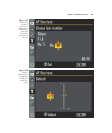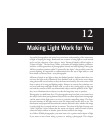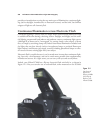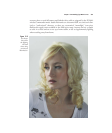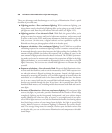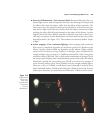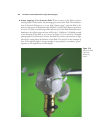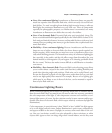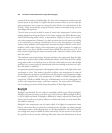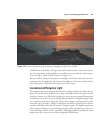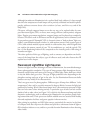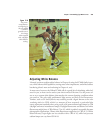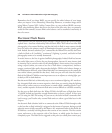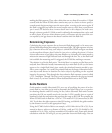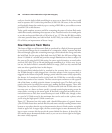
■ Cost—Pro: continuous lighting. Incandescent or fluorescent lamps are generally
much less expensive than electronic flash units, which can easily cost several hun-
dred dollars. I’ve used everything from desktop high-intensity lamps to reflector
flood lights for continuous illumination at very little cost. There are lamps made
especially for photographic purposes, too. Maintenance is economical, too: many
incandescent or fluorescents use bulbs that cost only a few dollars.
■ Cost—Con: electronic flash. Electronic flash units aren’t particularly cheap. The
lowest-cost dedicated flash designed specifically for the Nikon dSLRs is about $110.
Such units are limited in features, however, and intended for those with entry-level
cameras. Plan on spending some money to get the features that a sophisticated elec-
tronic flash offers.
■ Flexibility—Con: continuous lighting. Because incandescent and fluorescent
lamps are not as bright as electronic flash, the slower shutter speeds required (see
Action stopping, above) mean that you may have to use a tripod more often, espe-
cially when shooting portraits. The incandescent variety of continuous lighting gets
hot, especially in the studio, and the side effects range from discomfort (for your
human models) to disintegration (if you happen to be shooting perishable foods
like ice cream). The heat also makes it more difficult to add filtration to incandes-
cent sources.
■ Flexibility—Pro: electronic flash. Electronic flash’s action-freezing power allows
you to work without a tripod in the studio (and elsewhere), adding flexibility and
speed when choosing angles and positions. Flash units can be easily filtered, and,
because the filtration is placed over the light source rather than the lens, you don’t
need to use high-quality filter material. For example, Roscoe or Lee lighting gels,
which may be too flimsy to use in front of the lens, can be mounted or taped in
front of your flash with ease.
Continuous Lighting Basics
While continuous lighting and its effects are generally much easier to visualize and use
than electronic flash, there are some factors you need to take into account, particularly
the color temperature of the light. (Color temperature concerns aren’t exclusive to con-
tinuous light sources, of course, but the variations tend to be more extreme and less pre-
dictable than those of electronic flash, which output relatively consistent daylight-like
illumination.)
Color temperature, in practical terms, is how “bluish” or how “reddish” the light appears
to be to the digital camera’s sensor. Indoor illumination is quite warm, comparatively,
and appears reddish to the sensor. Daylight, in contrast, seems much bluer to the sen-
sor. Our eyes (our brains, actually) are quite adaptable to these variations, so white
objects don’t appear to have an orange tinge when viewed indoors, nor do they seem
Chapter 12 ■ Making Light Work for You 401



